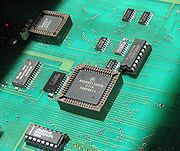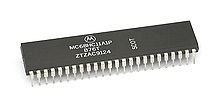- Freescale 68HC11
-
 The MC68HC11A8 is available in a 48-pin dual in-line package (DIP), as well as the 52-pin plastic leaded chip carrier (PLCC) as shown above.
The MC68HC11A8 is available in a 48-pin dual in-line package (DIP), as well as the 52-pin plastic leaded chip carrier (PLCC) as shown above.
The 68HC11 (6811 or HC11 for short) is an 8-bit microcontroller (µC) family introduced by Motorola in 1985. [1] Now produced by Freescale Semiconductor, it descended from the Motorola 6800 microprocessor. It is a CISC microcontroller. The 68HC11 devices are more powerful and more expensive than the 68HC08 microcontrollers, and are used in barcode readers, hotel card key writers, amateur robotics, and various other embedded systems. The MC68HC11A8 was the first MCU to include CMOS EEPROM.[2]
Internally, the HC11 instruction set is upward compatible with the 6800, with the addition of a Y index register. (Instructions using the Y register have opcodes prefixed with the byte 0x18). It has two eight-bit accumulators, A and B, two sixteen-bit index registers, X and Y, a condition code register, a 16-bit stack pointer, and a program counter. In addition, some instructions treat the A and B registers as a combined 16-bit D register.
The standard bootloader for the HC11 family is called BUFFALO, "Bit User Fast Friendly Aid to Logical Operation" (a BUFFALO prompt seen on the serial port at bootup is a sign that a board's flash memory has been erased). Not all HC11 models come with the BUFFALO bootloader. The 68HC11A0 and A1 do not but the A8 does.
Different versions of the HC11 have different numbers of external ports, labeled alphabetically. The most common version has five ports, A, B, C, D, and E, but some have as few as 3 ports (version D3). Each port is eight-bits wide except for D, which is six bits (in some variations of the chip, D also has eight bits). It can be operated with an internal program and RAM (1 to 768 bytes) or an external memory of up to 64 kilobytes. With external memory, B and C are used as address and data bus. In this mode, port C is multiplexed to carry both the lower byte of the address and data.
A MC68HC24 port replacement unit is available for the HC11. When placed on the external address bus, it replicates the original functions of B and C. Port A has input capture, output compare, pulse accumulator, and other timer functions; port D has serial I/O, and port E has an analog to digital converter (ADC).
In the early 1990s Motorola produced an evaluation board kit for the 68HC11 with several UARTs, RAM, and an EPROM. The cost of the evaluation kit was $68.11.
The Freescale 68HC12 is an enhanced 16-bit version of the 68HC11.
The Freescale 68HC16 microcontroller is intended as a 16-bit mostly software compatible upgrade of the 68HC11.
The Handy Board robotics controller by Fred Martin is based on the 68HC11.[3]
References
- ^ Hambley, Allan R.(1839). Electrical Engineering: Principles and Applications, Pearson Higher Educaion. p. 417. Digitized by Google. Retrieved on May 17, 2010.
- ^ M68HC11 Reference Manual
- ^ Handy Board Hardware
External links
- Freescale 68HC11 (Legacy) Part Info
- Wytec 68HC11 Development Board
- A fully synthesizable VHDL implementation of the HC11 CPU
- Digital Core Design 68HC11E - HDL IP Core
- Digital Core Design 68HC11F - HDL IP Core
- Digital Core Design 68HC11K - HDL IP Core
- Win/Linux-based freeware cross-assembler
- 4MHz-bus 68HC11F1-based board
This article was originally based on material from the Free On-line Dictionary of Computing, which is licensed under the GFDL.Motorola and Freescale microcontrollers Categories:- Microcontrollers
Wikimedia Foundation. 2010.

